Lisbon is simply one of the most incredible cities in Europe.
I’ve told this story before, but back in 2016, I arrived in town for the very first time. Within one day, I had fallen in love with Lisbon. Three days later, I decided I wanted to move there. And one month later, I was being handed the keys to my very own apartment. Yes, Lisbon is that irresistible!
Set upon seven hills, Lisbon has a long and rich history. It might surprise you to know that it’s said to predate Rome by 400 years. This gives the city the distinction of being the second oldest capital in Europe.
In 1755, Lisbon was destroyed by an enormous earthquake that led to raging fires and unleashed a tsunami on the city. By the end of the destruction, upwards of 50,000 people lost their lives in the city alone. Some estimates suggest that nearly 85 percent of Lisbon was destroyed. Thousands of homes fell to ruin along with palaces, churches, convents, libraries, and a massive collection of historical records and art.
By luck or by chance, the royal family had left for vacation earlier in the day and were spared any harm. Before the dust could begin to settle, the King and the prime minister determined to rebuild as soon as possible. Within a year, the debris was cleared away, paving the way for the reconstruction.
Some areas, such as the Baixa, were utterly obliterated. When the Baixa, meaning lower town, was rebuilt, it reflected a more modern linear layout. But areas such as Alfama survived and maintained the traditional narrow, winding pathways.
Despite all that destruction, Lisbon was able to re-establish itself, and there’s no shortage of things to do in and around the city. The architecture lover will not want to miss Jerónimos Monastery, Saint George’s Castle or Carmo Convent. A fado performance is a must and perhaps a stop at the Fado Museum for the music aficionado. History buff? There are 62 museums throughout the city to keep your grey matter spinning.
This post is going to be a long one, so I’ll stop rambling and instead share the absolute best things to do in Lisbon.
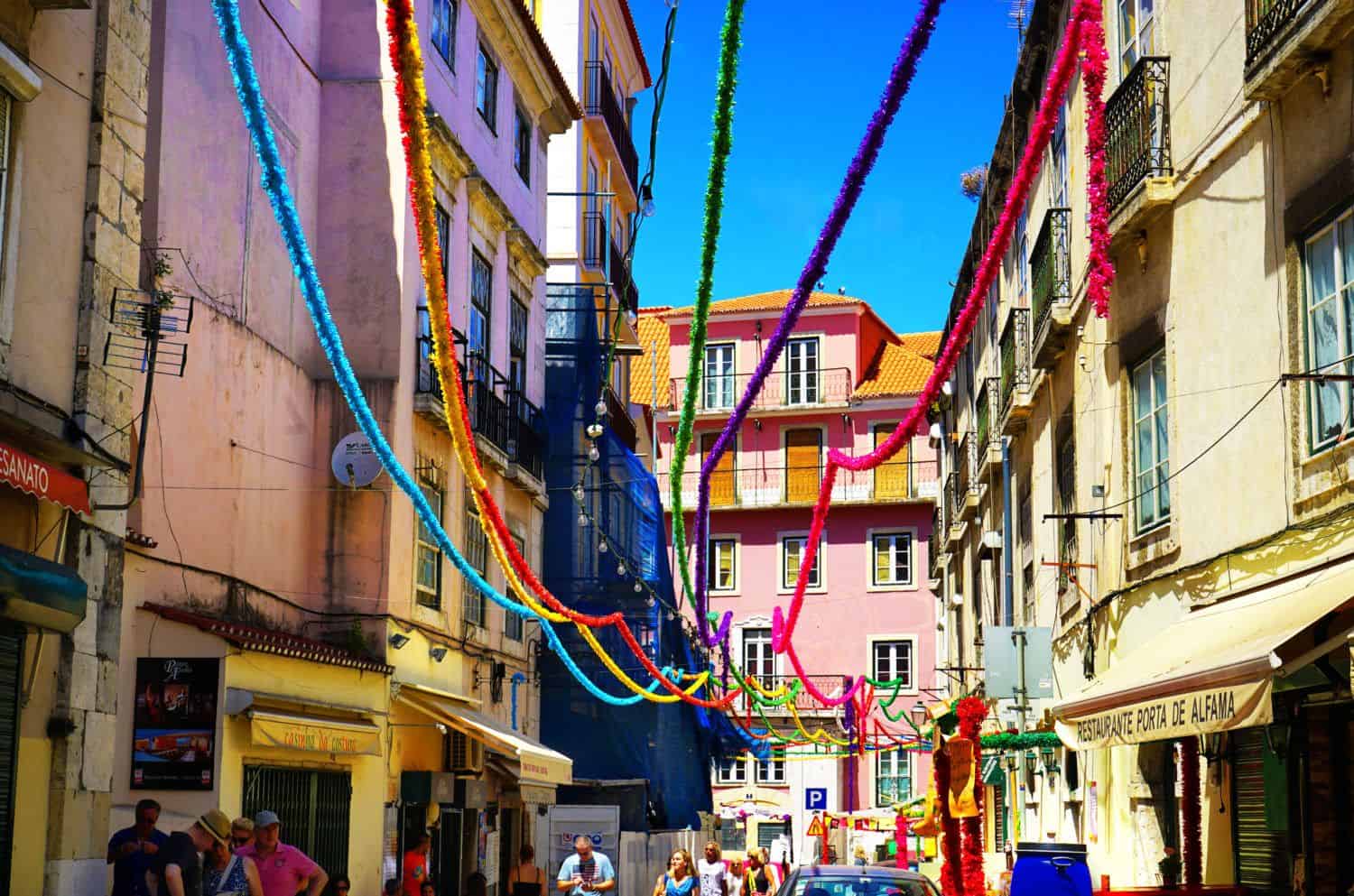
Wander Through Atmospheric Alfama
Yes, it’s crowded. Yes, it’s chaotic. But yes, it’s worth it.
The historic neighbourhood of Alfama is Lisbon’s oldest. In fact, it was the only part of the city that survived the devastating 1755 earthquake. In other words, if you want to see what Lisbon used to be like, this is where you come.
(Just know that this is where every other tourist also comes.)
Alfama oozes character and charm. A little word of advice if you stay here, dragging your wheeled suitcases around is no easy feat. The narrow and, at times, steep cobble streets make for challenging terrain. Plus, the maze-like alleyways are sure to have you turned around in circles for the first little while. But that’s all part of the adventure.
The Santa Apolonia train station, the oldest railway station in Lisbon, is a short walk away. Not only can you catch the underground there, but there’s also a small supermarket inside. This is where we would stock up on some food items to make some of our meals and snacks. I love heading to the local grocery store to scan the shelves for goodies I wouldn’t usually find at home.
Make sure you spend some time exploring the many alleys that make up the labyrinth of Alfama. If you are feeling adventurous, just let the streets guide you. You never know where the twists and turns will take you. In some instances, the alleys are no broader than the width of your outstretched arms. We got lost a few times, but we also found some cool shops and points of interest in doing so. However, if you’d prefer the comfort of a guided tour, there are plenty to choose from.
We also happened to be there in mid-June, during the Festas dos Santos Populares. In Lisbon, these celebrations honour St. Anthony and take place over June 12 – 13. Everywhere around us, colourful streamers adorned the alleys, and makeshift barbeques and restaurants were set up at various corners and squares. If you’ve ever had a craving for grilled sardines, this is the place and time to try them. On the night of June 12th, the festival takes off with the carnival that parades along the Avenida da Liberdade. Each city district is represented by its own dance groups and marching band and competes for the honour of best presentation. You can sense the excitement and pride of the community during this time.
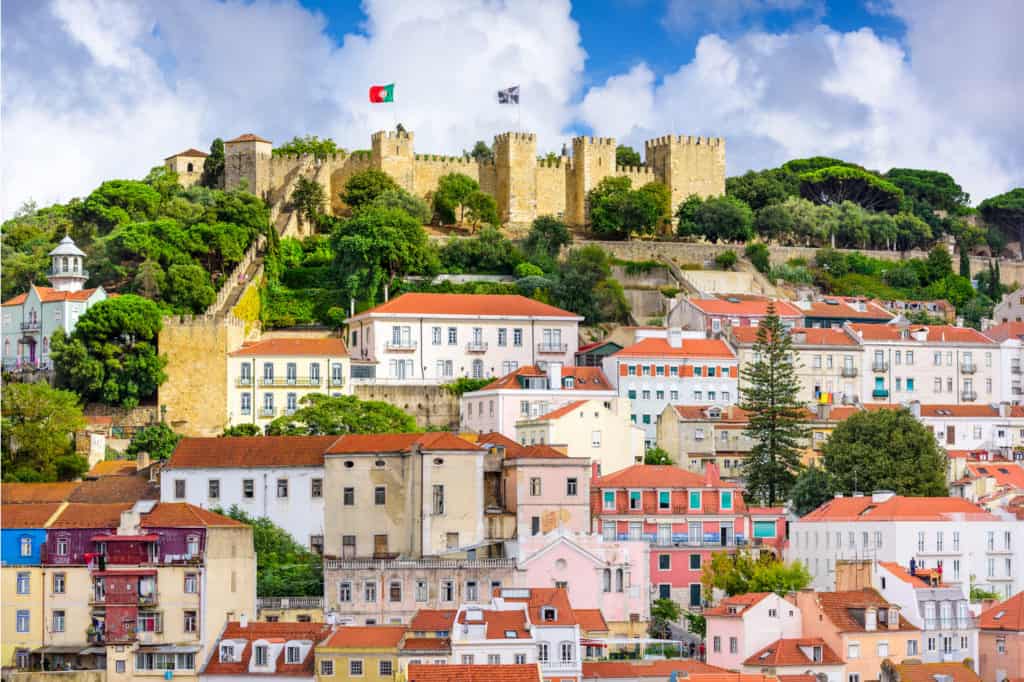
Castelo de. S. Jorge
It’s very easy to access Castelo de S. Jorge. As a matter of fact, we happened to stumble upon the exterior wall while out exploring on an evening stroll. Strategically located at the top of the highest hill in Lisbon, the castle still boasts 11 towers. The admission fee is €10 for adults and €5 for youth ages 13 – 25, and it is open seven days a week. Owing to its location, you can get some of the city’s best views from the castle. And one of the coolest features is the Camera Obscura. It is in the Tower of Ulysses and provides guests with 360◦ views of the city in real-time. In addition, there are a few activities to check out at the castle, including gardens, permanent exhibitions, a café, and a restaurant.
From there, we also came upon a beautiful terrace, the Miradouro de Santa Luzia, that overlooks old homes and provides spectacular sweeping views of the Tagus River. It’s a great place to linger a while to soak in the reflection of the full moon glistening along the surface of the river. We continued our stroll, and somewhat lost, we passed several small restaurants nestled along the alleyways. Through the doors, we could hear the telltale sounds of Fado trailing through the air.
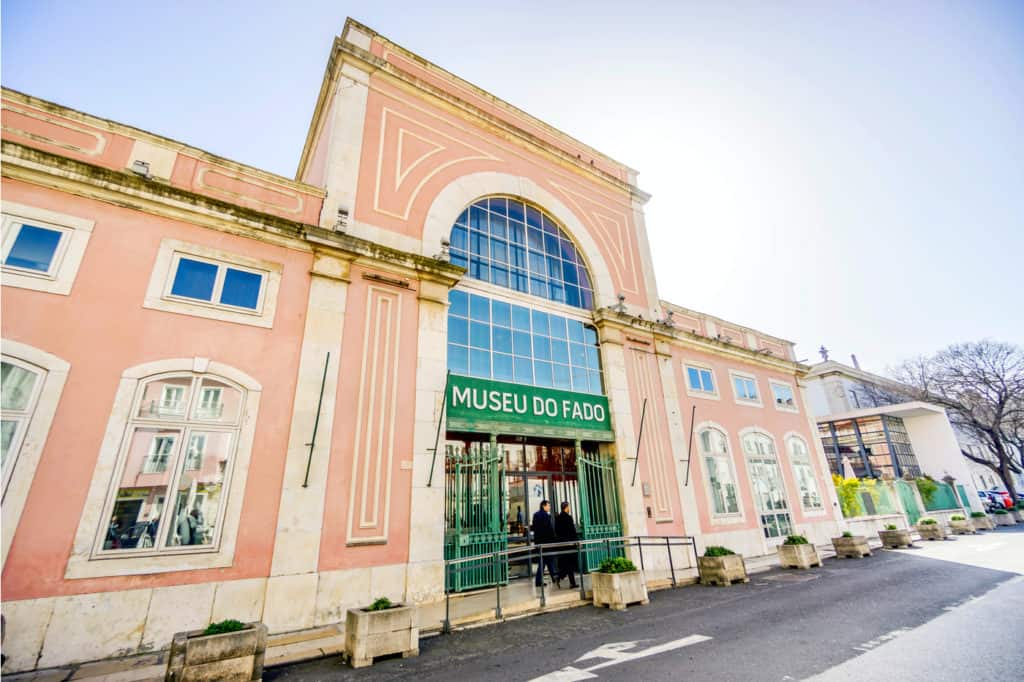
Fado Museum
A Fado performance is a must if you are a music connoisseur in search of distinct music vibes. Fado, recognized as part of the UNESCO Cultural Heritage of Humanity, dates back to the early 1800s. It is known for its melancholic style and is traditionally sung to reflect life’s struggles and hardships. For a more in-depth look, you can get yourself better acquainted with all things Fado at the Fado Museum. And since Alfama is considered the birthplace of Fado, it is only fitting that the Fado Museum is located right across from Alfama Old Town Square.
After the museum, it’s time to find a place to go and enjoy a performance. There is no shortage of places to go, from full-sized restaurants to quaint little taverns. I prefer to head to one of the cozy, tucked-away taverns as there’s something about the small venue to imparts a sense of intimacy and authenticity. One such place is Tasca Do Chico (Note: there is also a location in Bairro Alto). The place is quite rustic and small, with almost every square inch of wall covered in photographs of celebrities who have visited the tavern. Be sure to get there early as space is limited and the place gets packed, and keep in mind that it’s cash only. Tasca Do Chico is also popular with the locals, so you know you are getting the real deal.
If you are in the mood for a more refined dining experience, you may want to try Casa de Linhares. Housed in an old renaissance mansion once home to nobles, the restaurant possesses a natural warmth and charm courtesy of the vaulted stone ceilings, massive timber beams, and fabulous mood lighting. The menu has generous offerings, including a selection for vegetarians (not just a salad!). There is a show fee of €15, and it is possible to make reservations by phone or online.
For those who prefer the company of fellow travellers, there is also the option of taking a guided group tour. On this four-hour excursion, you will enjoy a traditional Portuguese dinner, then embark on a walking tour through Alfama, and end the evening with a Fado performance. The price starts at €39 per person.
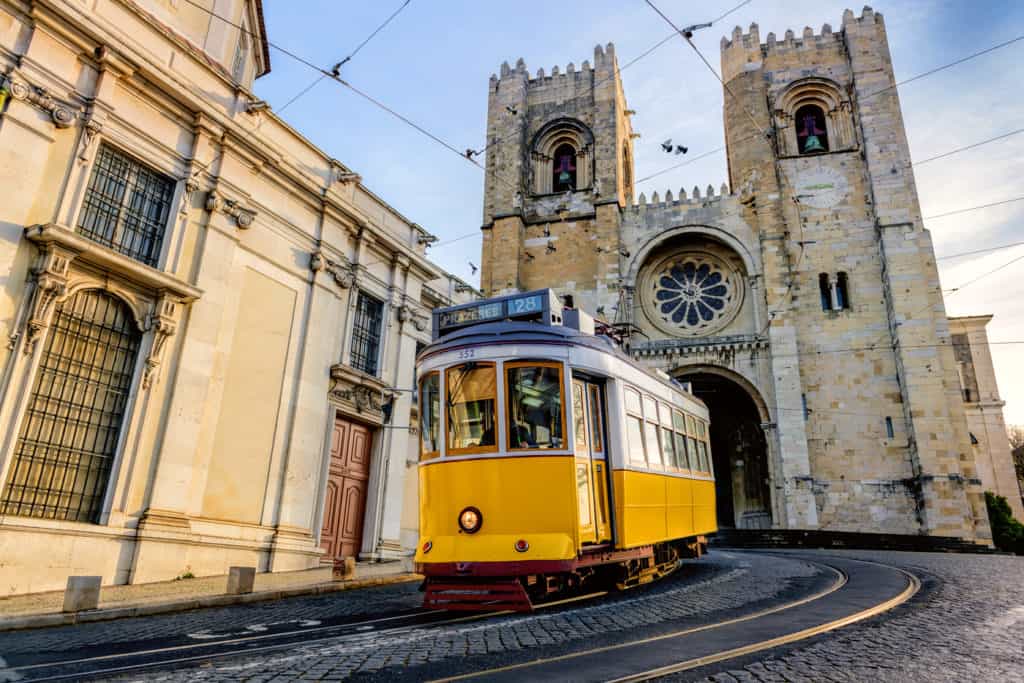
Tram E28
Of all the iconic yellow trams (or Remodelado) in Lisbon, none is more well known than E28. For may venturing to Lisbon, a ride on E28 is on their list of must-dos. But there is some debate as to whether it’s worth the hype. It is known to be overcrowded and requires long waits. Unfortunately, it’s also a popular spot for pickpocketers looking to capitalize off preoccupied travellers. It does, however, pass through the major tourist neighbourhoods, including Baixa and Estrela, and is the only form of public transportation that can maneuver the tight alleyways in the Alfama district. The cost to board is €3, and a bonus is that it runs frequently throughout the day. Once the line reaches its final stop, the tram completes the same route in reverse.
If your heart is set on hopping on the tram for the experience, other options aren’t as crowded. You can take the E24 tram which travels from Praça Luís de Camões between Chiado and Bairro Alto, through Príncipe Real, ending in Campolide. This route is not as scenic as the E28, but you’ll appreciate the quiet and may actually get a seat.
We decided to take a pass on the tram and opted to snap a nice picture of it passing by us instead. But if it’s something on your bucket list, then it’s a great way to do some sightseeing in a very authentic setting. Just remember to have your wits about you and secure your valuables in your bag in front of you.
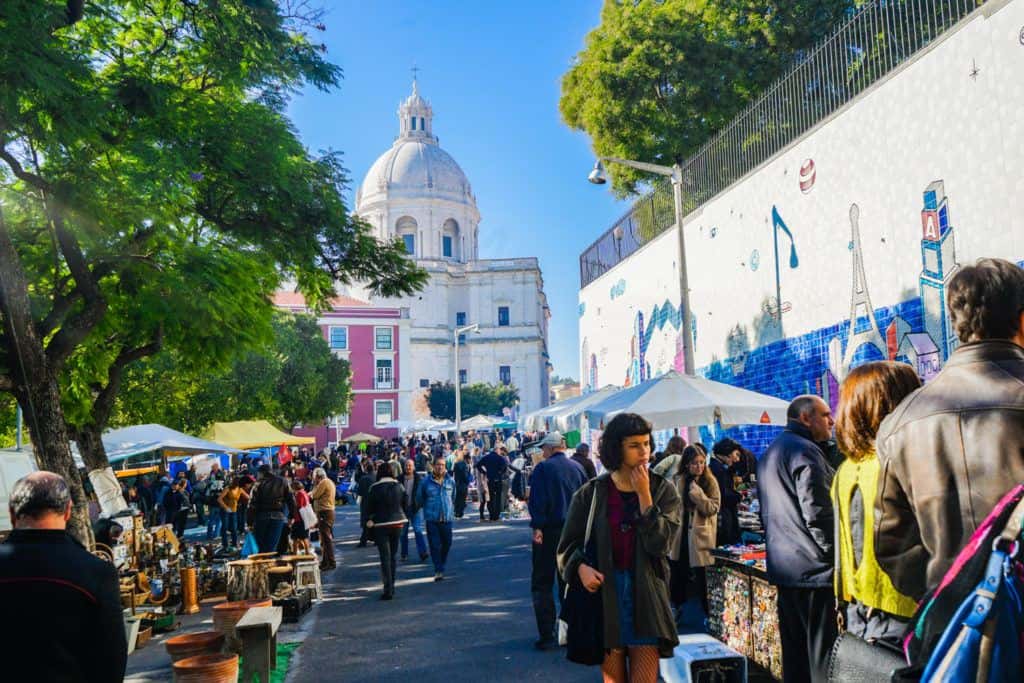
Feira da Ladra
If you happen to be in Alfama on a Tuesday or Saturday, you might want to take time to visit the oldest flea market in the city. Don’t let the name fool you – though it translates to Thieves Market, rest assured that everything here is legit. Head to the Campo de Santa Clara square early for the best goods, and don’t be afraid to haggle. There are all kinds of items to be found here, ranging from antiques, handmade products, second-hand items, records, tiles – you name it! A bonus of checking out this market is that once you are done, there are other points of interest in the vicinity worth taking note of, namely the National Pantheon (formerly the Santa Engracia Church) and São Vicente de Fora Monastery.
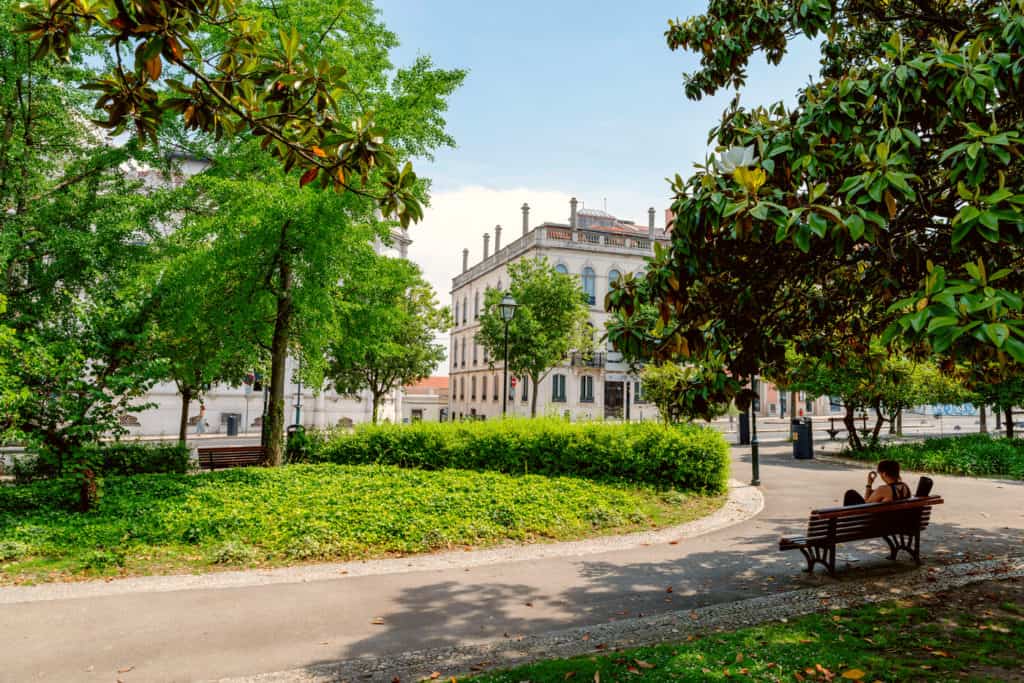
Príncipe Real
Located just north of Bairro Alto, you’ll find Príncipe Real, an affluent area known for its beautiful 19th-century mansions, boutiques, antique shops, and plenty of fine dining. One of the key features of this district is the Jardim do Príncipe Real, the centre of which is a century-old cedar tree with branches spanning 20 meters. This is a great place to enjoy a gentler pace, to stop and relax. If botanicals are your thing, the Botanical Garden dating back to 1878 is also in this district. It is home to approximately 1300 – 1500 plant species, including many from Australia, New Zealand, China, and South America. The entrance fee for the Botanical Garden is €3.
The Embaixada is a unique shopping gallery housed in an Arabian-inspired palace that was built in 1857. Inside, you will find many of the original details and shops focusing on Portuguese design and culture. On Tuesday nights, the restaurant in the inner courtyard offers Fado performances.
One other highlight of the district is that it, along with neighbouring Bairro Alto and Chiado, is home to Lisbon’s gaybourhood. For a night of dancing or a fun drag performance, head over to Finalmente Club at Rua da Palmeira 38. They are open every day from 10 p.m. with drag shows at 11:15 p.m.

Igreja de São Roque
With its unassuming white façade, it would be easy to assume there’s nothing much to see at the Igreja de São Roque. But one step inside the church reveals its lavish gold and marble interior. Dubbed by some as the most beautiful church in Lisbon, the jewel in this church’s crown is the Chapel of Saint John the Baptist. Originating from Rome, the Chapel is constructed of alabaster, marble, amethyst, gold, silver, and lapis lazuli. This is my kind of place because the devil is in the details, and the details abound. Entrance to the church is free so take the time to take it all in. If you’d like to visit the adjoining museum, it is €2.50 (free on Sundays).
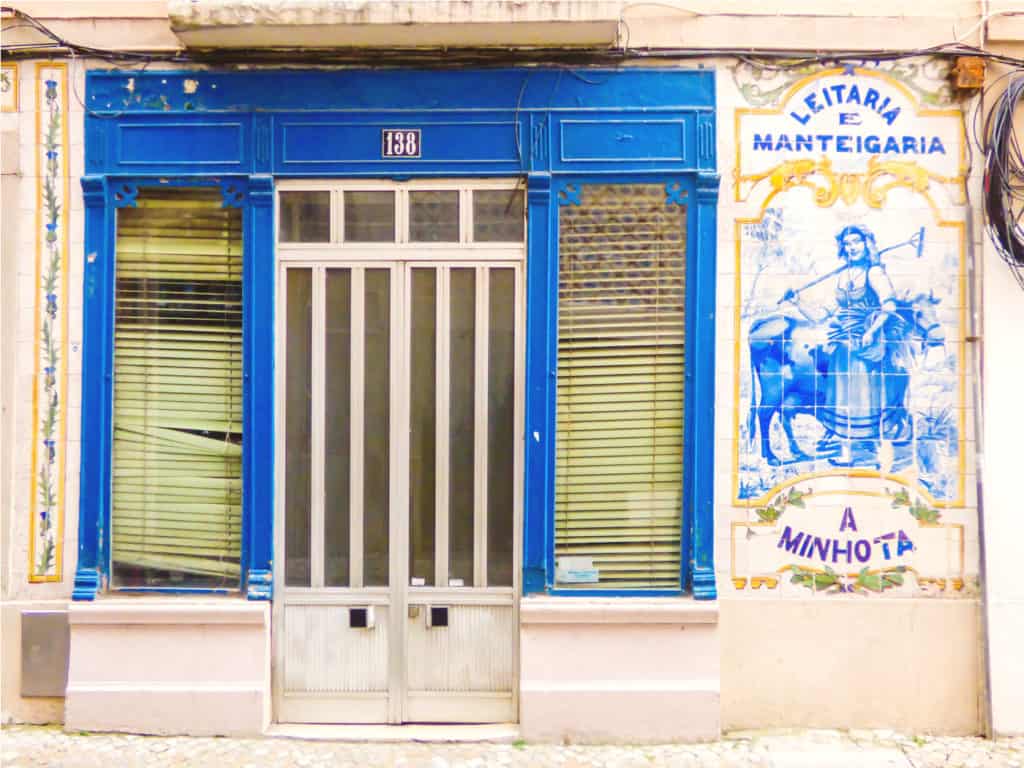
Manteigaria
The Pastéis de Belem has some stiff competition from Manteigaria. This pastéis de nata factory, once a butter shop, offers patrons the unique opportunity to watch the production of the sweet custards from start to finish. Once you hear the bell ring, that means a fresh batch is making its way out of the oven. At €1 per piece, it is well worth getting yourself a box and a coffee to go.
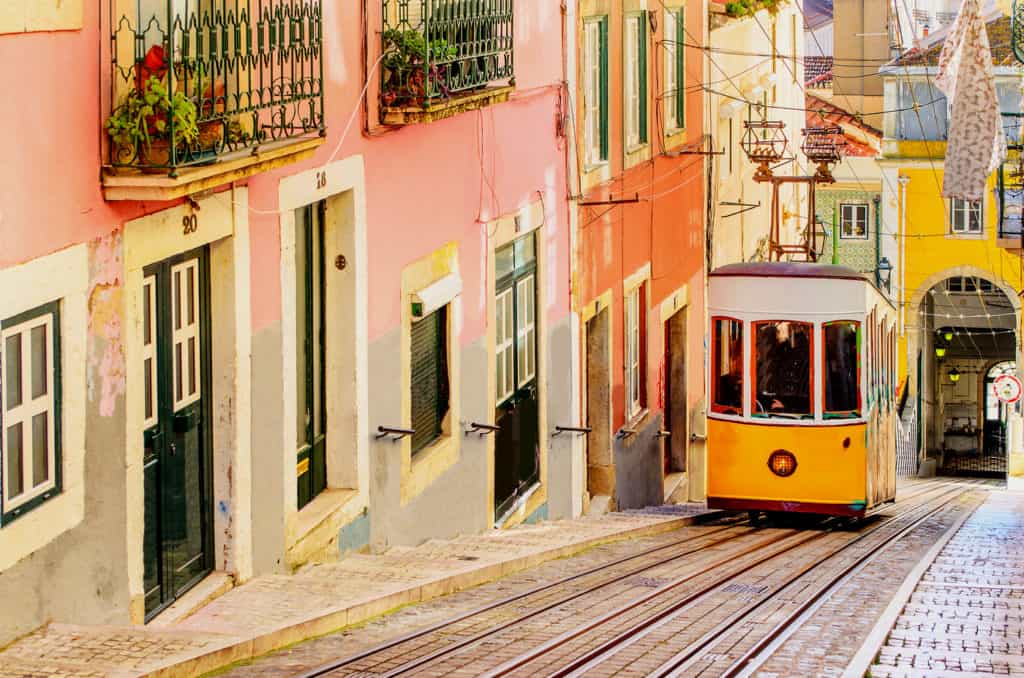
Elevador da Glória
Built in 1885, the Elevador da Glória is one of three funiculars in Lisbon. The cable car looks just like the Remodelados but transports riders up and down the hill that connects Rua San Pedro de Alcántara in Bairro Alto to Praca Dos Restauradores. At the top of the hill, next to the funicular, is the Miradouro de São Pedro de Alcántara. This space is a lovely garden that provides panoramic views of central Lisbon and the Castelo de. S. Jorge. The cost of a ride is €2.90.
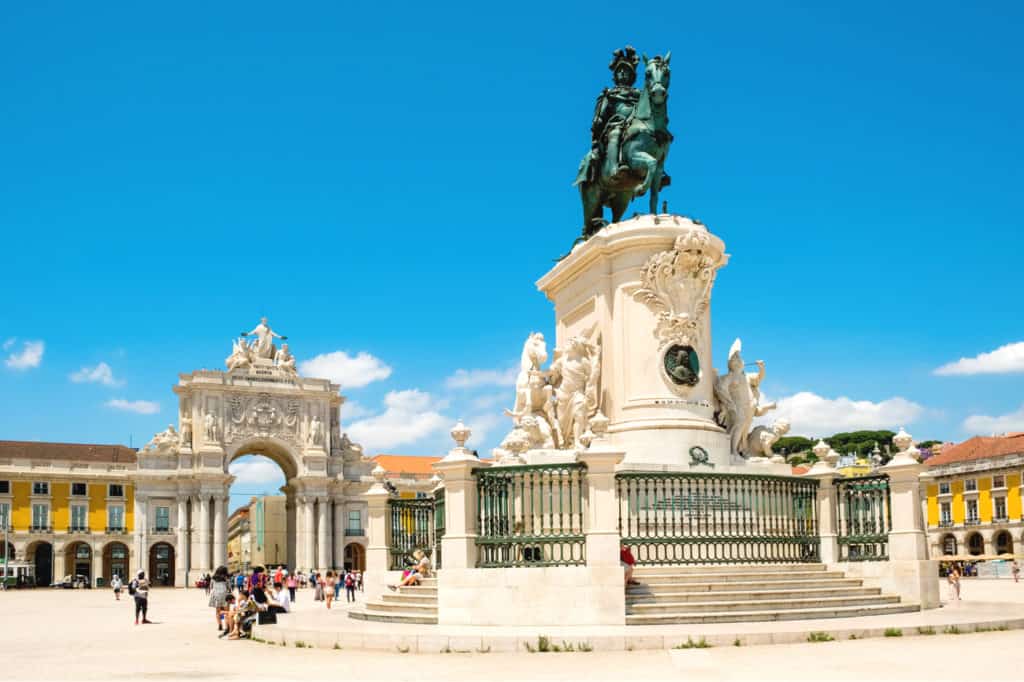
Praça do Comercio
On the shores of the Tagus River, this stunning plaza is considered the gateway to the city. The square is lined with vibrant yellow buildings built in the neoclassical style, and there is a grand statue of King Joseph I at the centre. In addition, there is a viewing platform located in the magnificent archway over the entrance to Praça do Comercio. For a fee of €2.50, you can enjoy spectacular panoramic views of the Baixa district. Here, you will gain a genuine appreciation for the modern layout and architecture that dominated the reconstruction. Before heading off to other areas in the district, you may want to visit the Martinho da Arcada, the oldest café in the city, found in the northern arcade.
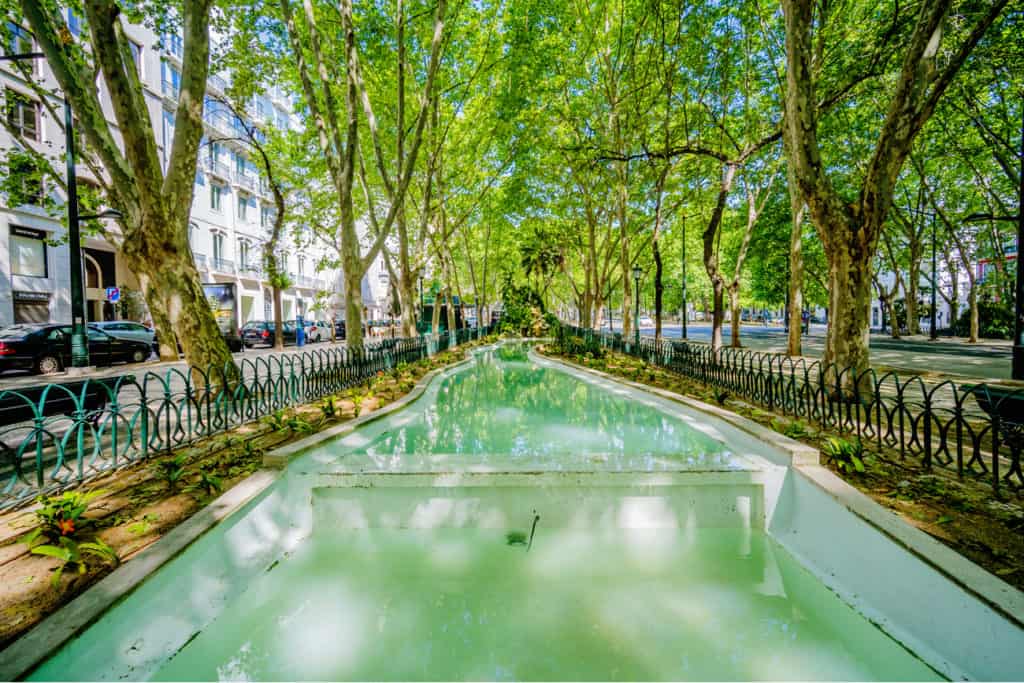
Avenida da Liberdade
This beautiful tree-lined avenue known for its designer shops and cafes is the city’s main boulevard. At just over 1.5 km in length, it ends in a roundabout where you will find the Marques de Pombal Square. This space features a monument honouring the prime minister who rebuilt Lisbon after the destruction caused by the earthquake in 1755. Directly behind the monument is Edward VII Park. The park’s landscaping is a standout as the neatly trimmed hedges form a geometric pattern. If you love plants, you’ll be pleased to know there are two greenhouses in the park that house exotic plants, palms, and cacti. Entry to the greenhouses is free with a Lisboa card.
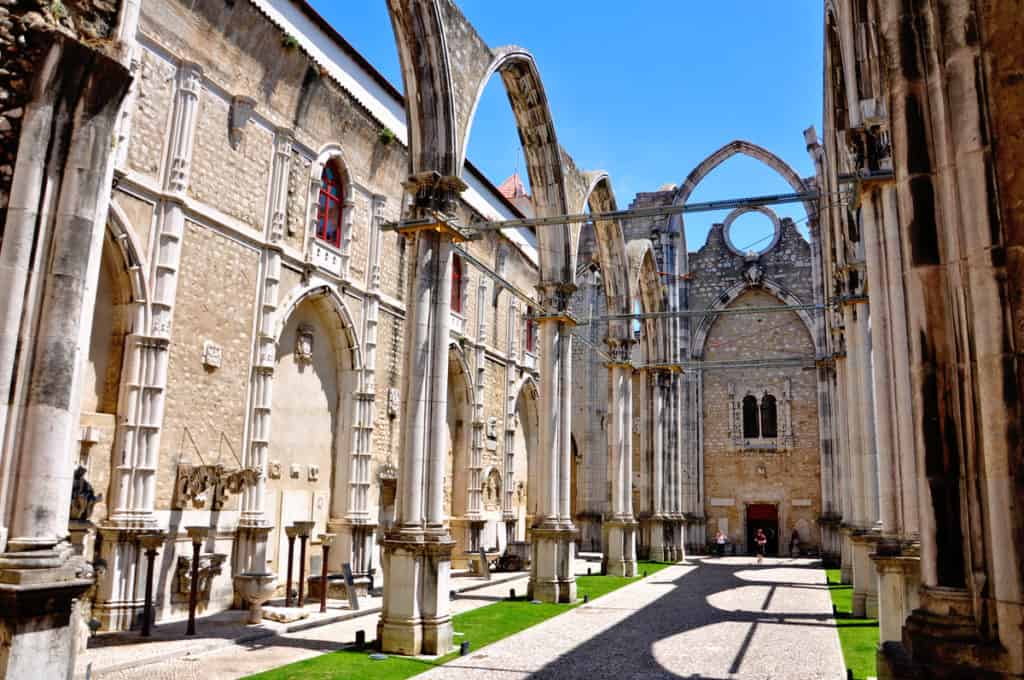
Carmo Convent
The former Catholic convent was all but destroyed in the Great Earthquake and what you see is the remains of that devastation. However, many of the arches still stand, and the former altar is now the site of an archaeological museum with a collection of tombs, ceramics, shrunken heads, and other artifacts.
If you are in the Baixa and want to access the convent, you can take the Elevador de Santa Justa. This is a fascinating structure, and not like any I’ve seen before. It’s quite literally a stand-alone elevator in a metal tower that is 45 meters high. Aesthetically, it’s quite beautiful as the exterior is constructed out of iron in the neo-gothic style. The return fare is €3.50, but if you happen to have a 24-hour public transit pass, the elevator is included as it falls under the umbrella of the public transit system. In addition, there is a viewing platform at the top, which costs €1.50 to access.
Belém
This area is well worth spending the day to visit and is jam-packed with cultural highlights to explore. Way back in the day, Belém was a significant gateway for explorers journeying to the open sea. That period became known as the Age of Discovery. Many notable explorers commenced their travels through these passages, including Vasco de Gama and Magellan. All within a short walking distance, you will find museums, gardens, monuments, and palaces. However, if you are only there for a day, you will want to be sure to hit up some of the most iconic places in the area.

Jerónimos Monastery
Designated a UNESCO World Heritage Site, the monastery is significant in Portuguese history as it served as a place of prayer for many of the early navigators during the Age of Discovery. For example, Vasco da Gama and his crew prayed at the church before departing on his voyage, searching for India.
On the day of our visit, the glowing sun and cloudless blue sky were the perfect backdrops to the sandy-coloured façade of the imposing monastery. At a length of 300 meters, when you are standing in front of it, the magnitude of the complex is quite striking. Construction on Jerónimos Monastery started in 1501 and took 100 years to complete. The monastery was built in the 16th-century Manueline style and is fully adorned with religious and nautical reliefs. I absolutely love architecture and can easily spend hours getting lost in these structures’ elaborate and intricate details. If you place yourself at the centre of the inner courtyard, you will find this the perfect spot to soak in the beautiful details of the two-story cloister. I also recommend taking a seat on the steps surrounding the courtyard and just taking a moment to really enjoy the peacefulness of the space. The cost of entry is €10.
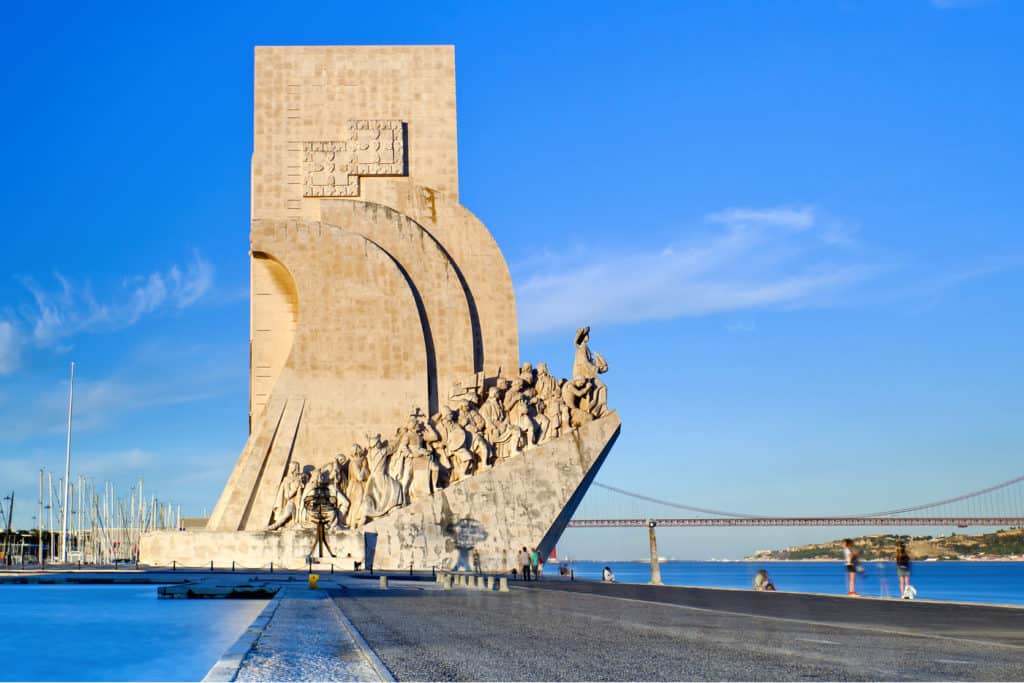
Monument to the Discoveries
Ever wonder where your Magellan GPS got its name? It only makes sense that these navigation systems are the namesake of Ferdinand Magellan, the renowned Portuguese explorer who was the first to circumnavigate the globe. You can find a sculpture of Magellan and numerous other famed explorers carved on the sides of the monument. The structure takes the shape of a stylized caravel and stands at 52 meters tall. Inside the monument, visitors can take an elevator (or climb nine flights of stairs) to the rooftop to enjoy views of the Tagus River and the surrounding area. There is also an exhibition hall where various exhibits take place throughout the year. The monument is located on the northern banks of the Tagus River, a mere 600 m from the Jerónimos Monastery, and was built to celebrate the 500th anniversary of the death of Henry the Navigator. The entrance fee is €6 and includes entrance to the exhibition, rooftop and film. A ticket for the exhibition alone is €3.
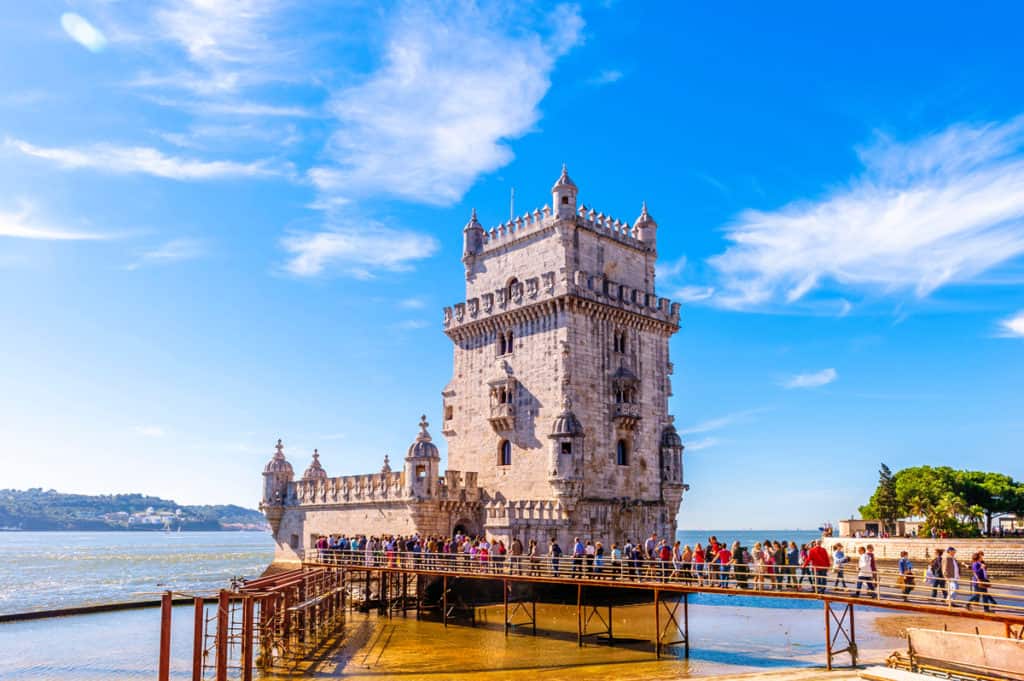
Belém Tower
One look at this structure, and you can tell it was built to last. Its solid square shape speaks to its use as a military fortification. Built in 1515, the Tower served as a gateway to the city and was used to prevent enemies from entering and, at one point, was also used as a prison. Much like the Jeronimos Monastery, the Tower is built in the Manueline style.
A visit won’t take particularly long as it is not exactly a large space. But it is a neat experience to sit in one of the old windows and imagine what other long-ago characters sat in that very place, casting a watchful eye over the Tagus River.

Pastéis de Belém
A trip to Belém is not quite complete unless you make your way to the renowned bakery acclaimed for their traditional egg custard tarts – pastéis de nata. While it is true that you can find these custard tarts throughout Portugal, their secret recipe originates from the nearby Jeronimos Monastery, and these sweet treats have been made using traditional methods since 1837. Usually, people are lined up out the door, but the line was pretty short on the day we passed by. So perhaps the trick is to wait until later in the day.
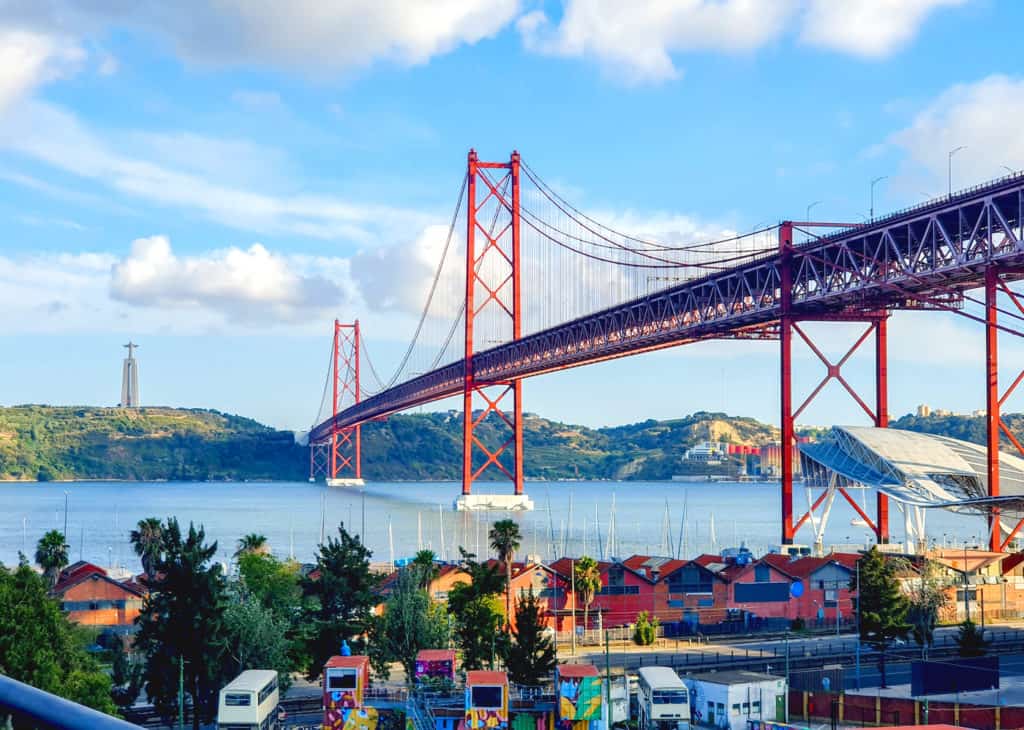
25 de Abril Bridge
There is no need to travel all the way to San Francisco to see the Golden Gate bridge. If you are in the mood for a walk after visiting the Monument to the Discoveries, it is only 2.5 km on foot to get to the 25 de Abril Bridge. Modelled after the Golden Gate, the suspension bridge is one of the longest in Europe. If you plan to drive across it, there is a toll of €1.85 per car. Unfortunately, it is not possible to walk across the bridge, but if you make your way to Pilar 7 (of 14), an elevator will bring you to an observation deck, allowing you to view the bridge at the street level. The entrance to Pilar 7 is located behind the LX Factory, and the fee is €6.
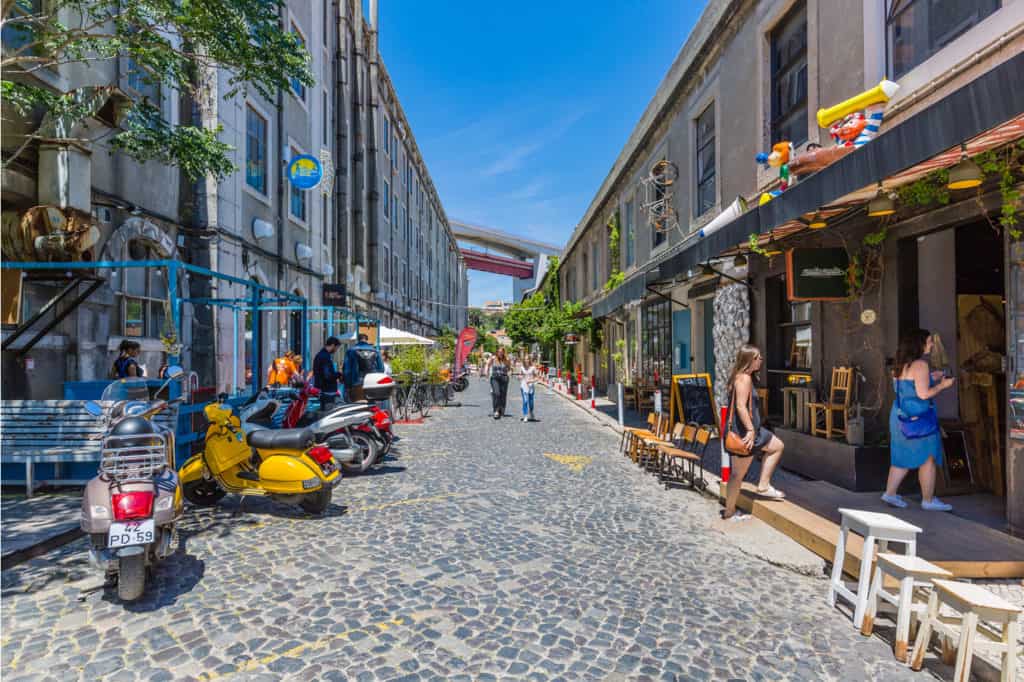
LX Factory
A former industrial complex near the 25 de Abril Bridge, LX Factory has been transformed into a modern hub of innovation that will have creative types swooning. Combining indoor and outdoor space, the complex is home to over 50 concept shops, restaurants, coffee shops, and bars. There is plenty of street art throughout, including a massive bee made of garbage and art installations. Be sure to check out the fabulous bookshop, Ler Devagar. Bibliophiles will drool over the floor-to-ceiling book stacks housed in a former print shop that still has an original printing press onsite. LX Factory is also a popular location for weekend brunch, a Sunday Market, and several events and exhibitions, such as the Lisbon Coffee Fest.
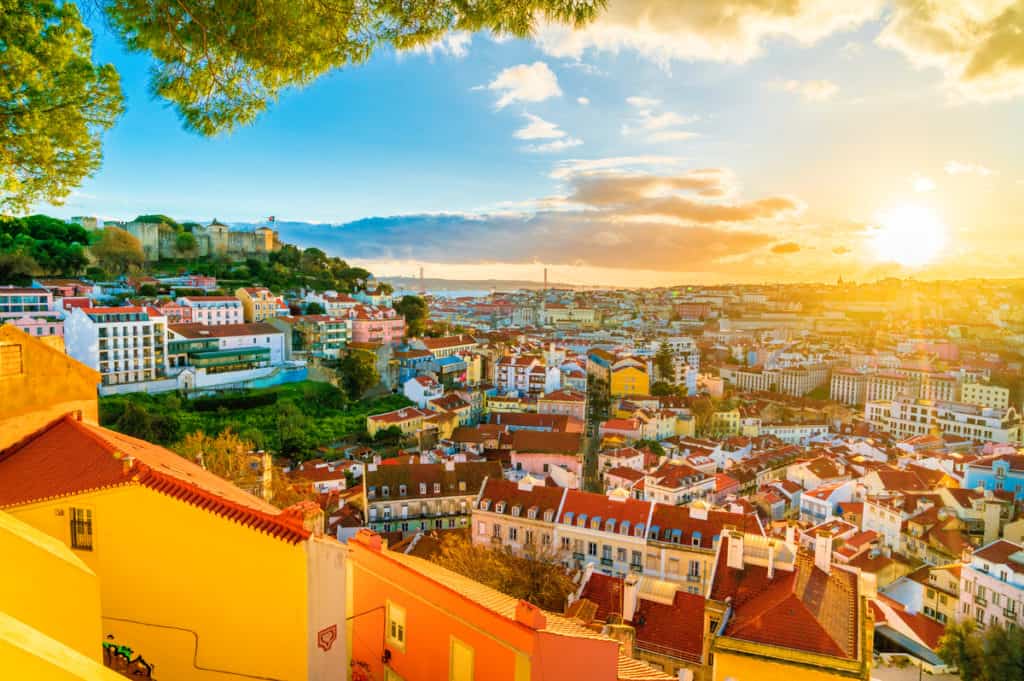
And That’s Lisbon!
So there you have it, a taste of some of the best things to do in Lisbon.
If you can imagine, this is still not a complete list of everything there is to do in this ancient city. There is something to cover every interest – history, music, architecture, food, fashion, design – you name it! Lisbon is truly a hub of culture and history. The best thing to do is arm yourself with a great pair of walking shoes (you’ll need them with all those hills) and make your way through each district. Really get in there and explore. Get lost in Alfama. Party to your heart’s content in Bairro Alto. Relax under the shade of a giant cedar umbrella. Ride the funiculars. And when it’s all said and done, head to the nearest miradouro with an espresso and a box of pastéis de nata to sit and reflect on your fantastic journey.
Related Articles on Portugal
💰 The Cost of Travel in Portugal: A Detailed Budget Breakdown
🇵🇹 After 70 Countries, Why I Moved to Lisbon, Portugal
❤️ 28 Best Things to Do in Porto, Portugal
🏝 13 Reasons to Plan a Trip to the Azores
🏚 Exploring the Abandoned Monte Palace Hotel in Sao Miguel

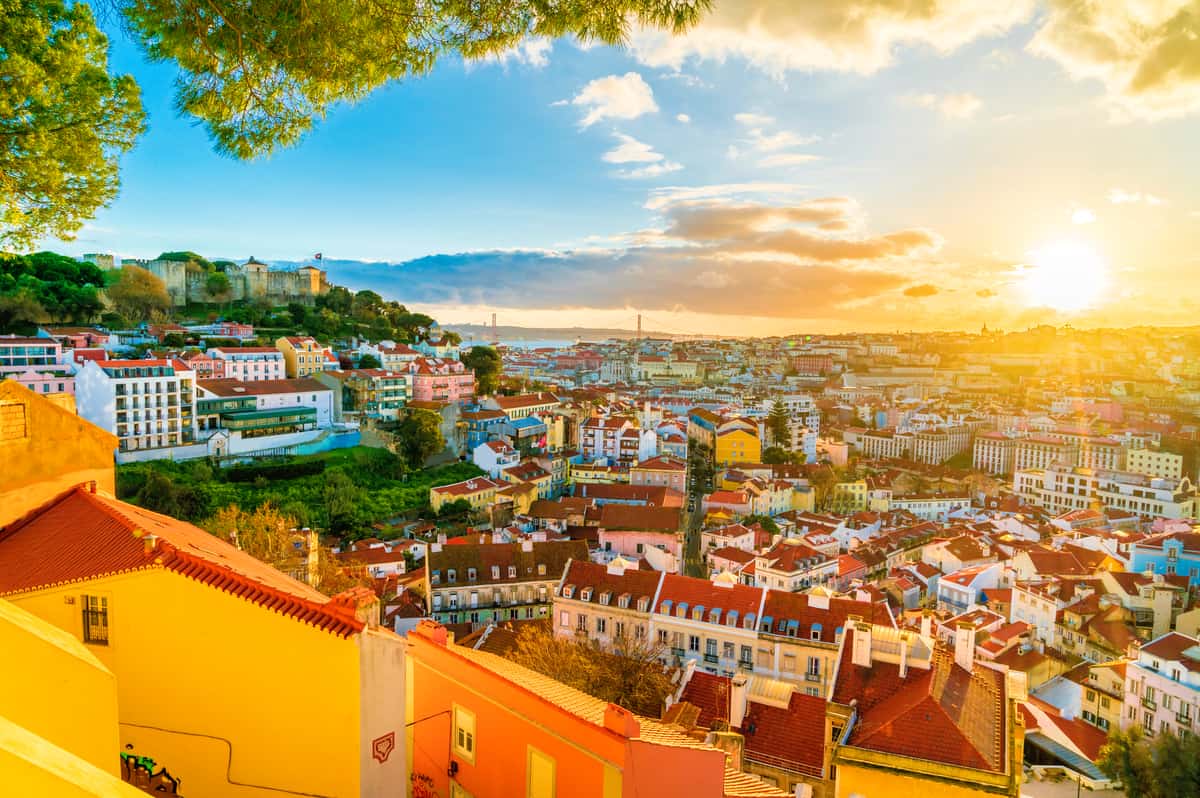


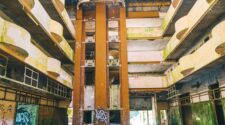
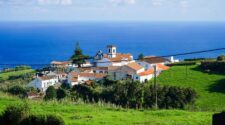


No Comment